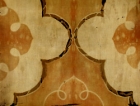Japanese Archaeology and Special Exhibition (Heiseikan) Thematic Exhibition Room
November 2, 2010 (Tue) - November 28, 2010 (Sun)
The Tokyo National Museum collection includes over 260 textiles from the Shosoin Repository preserved between plates of glass. These were transferred to the museum at the beginning of the Meiji period (1868-1912) for preservation and design research purposes.
The Shosoin textiles demonstrate a wide range of textile production and design techniques. Dyed textiles include examples of brush dyeing and the three ancient forms of resist dyeing: tied resist, wax resist and clamp resist. Weaves include heiken plain weaves, textiles with interwoven designs such as twill, ra gauze and colorful brocades, and embroidery is also represented.
Following last year's thematic exhibition of Shosoin textiles highlighting weaves, this exhibition focuses on dyeing. As the Shosoin textiles in the museum's collection are stored between plates of glass, only small samples are held; even so, it is possible to infer the usage of each piece based on the fabric type.
Textiles for which the period of usage is known include banners used in the eye-opening ceremony for the Great Buddha of Todaiji temple and bugaku costumes from performances held on the same occasion, as well as streamers from the banner used at the first memorial ceremony for Emperor Shomu. The collection also includes fragments of banner sections, streamers and pendent canopy decorations from one of the largest banners preserved at the Shosoin - a lined, five-sectioned work dyed in clamp resist.
The museum additionally houses illustrative reproductions of Shosoin textiles produced at the end of the Taisho era, and selected examples of these are shown together with the textiles they represent. This exhibition illustrates the advanced techniques of ancient textile artisans, who produced these innovative dyed designs over 1,200 years ago.

